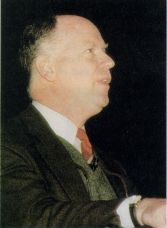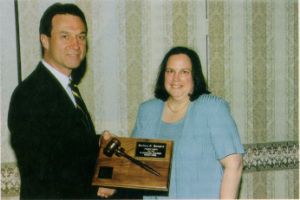Aha, Michael Jordan, so it wasn?t the shoes after all, eh? It was the work space.
Or maybe it was the work space at Converse, where basketball master Jordan originally assumed he?d sign for his 1984-85 pro rookie season. Then, however, he visited Converse?s offices and decided ?they just looked traditional.? So the fiercely innovative Jordan signed instead with Nike, which he?d originally only granted a courtesy visit. But Jordan liked Nike?s more non-traditional work space.
You know the rest of the story: For the want of a snazzy workplace, sports shoe empires were lost and won.
Roulac Group Principal Stephen Roulac cited that anecdote (drawn, he said, from Jordan?s book, For the Love of the Game), during the recent New England World Congress of the International Development Research Council (IDRC), the world?s preeminent association of corporate real estate executives.

Convened in Boston, IDRC?s biannual get-together sharply focused on the fast-changing corporate workplace, attracting a record turnout that underscored the observation of another notable that Roulac quoted, business guru Tom Peters:
?Space management,? Peters wrote in Liberation Management, ?may well be the most ignored and most powerful tool for inducing cultural change, speeding up innovation projects and enhancing the learning process in far-flung organizations.?
Peters, however, wrote that in 1992. Today, on the 21st century?s cusp, workplace power is definitely no longer ignored, due in no small part to IDRC?s cutting-edge efforts. Yet more insights from the workplace cutting edge came to the fore at IDRC?s New England parley, with its new-age theme of ?A Performance Revolution: The Competitive Advantage of Place, Space and Technology.?
Above right: Ever-more powerful technology will mean robust economic growth for the next two decades said Kiplinger Letter Editor Knight Kiplinger.
For example, Michael Joroff, the Massachusetts Institute of Technology senior lecturer who?s been a leader in IDRC?s research, observed, ?The workplace has become as much a state of mind, an attitude, as it is a physical place.?
Indeed, onetime way-out-in-left-field real estate strategies have solidly positioned themselves at center stage in the global business arena.
?Eighty percent of American corporations are doing some form of alternative officing,? Joroff said. ?The alternative office isn?t alternative anymore; it?s in the mainstream as one choice people can make to bring the workplace together.?
The Workplace-Cyberspace Convergence
Among the recurring themes at IDRC?s Boston gathering, one of the most powerful was digital technology?s transforming impact on both business and the workplace.
Kiplinger Letter Editor Knight Kiplinger, for example, forecast robust economic growth for the next two decades, fueled primarily by technologies like telecommunications, biotechnology and factory automation.
James Canton, Institute for Global Futures president and author of Future Smart: Business Intelligence for the 21st Century Professional, ventured even further: ?Knowledge-based digital technology,? he said, ?is inevitable as an evolutionary force transforming our lives and culture.?
Already, digital technology?s dominance is adding yet more discontinuous change to the business milieu, explained business strategist and author Adrian Slywotzky.

?The rules defining business success are changing,? said Mercer Management Consulting Vice President Slywotzky. Ten years ago, for example, Microsoft, Lotus and Apple had almost equal value, as did Wal-Mart and K-Mart. ?Now Microsoft is several dozen times more valuable, far more valuable than Lotus or Apple, and Wal-Mart is worth 20 times as much as K-Mart,? Slywotzky said.
As those rapid upheavals suggest, speed rules the new business order. Business design life cycles, which once unfolded over 15 to 20 years, now burn up ?in more like five or six years,? Slywotzky explained. ?Those companies that reinvent themselves every five years are most successful. Everyone is thinking about the next new winning business design.?
Above right: Success now lies in “reinventing
Likewise, digital-age work-space design is in rapid flux. In fact, much like ?his Airness,? Michael Jordan, corporate real estate is starting to transcend simple physical space, Joroff explained.
?The workplace of the future will not be bricks-and-mortar, and it won?t be cyberspace,? Joroff asserted. ?It will be a mix of the two, intermingled. The fact is, we have to work and be in both places. Work is now multiple people working in multiple places.?
Adding Value Electronically
Much value-adding work, several Boston speakers explained, has already migrated to cyberspace, where virtual reality is being employed in facility and product design.
Boeing, for instance, used teams and individuals in 237 different locations to design one of its technologically complex aircraft. Ford?s Detroit design center was co-designed by project teams dispersed around the world.
Many other firms, Boston speakers explained, have set up ?computer-supported team space? that supports physically dispersed teams that collaborate online.
Those new work space forms echoed Canton?s observation: ?We?re moving to the next step in cultural evolution: a knowledge-based digital global culture connected by the Net.?
Said Joroff, ?Clustering is important, but it no longer has to be physical. In some cases, clustering is happening by one physical node communicating to another physical node. The value they add is added electronically.?
Trends Buttress CIR Push
Technology?s formidable workplace impact ? which came through broadband-clear in Boston — accentuated another important new direction: corporate infrastructure integration, the fast-growing trend to align real estate with other support functions like finance, information technology (IT) and human resources (HR) to optimally support corporate strategy. As DEGW Chairman Frank Duffy commented, ?At the start of this century, the only way to run a business was to keep all the units separate. But at the end of this century, the only way to run a business is to integrate all the units.?
IDRC has become a thought leader in that snowballing cross-functional push, adopting Corporate Infrastructure ResourcesTM (CIR) as the core element in its research and education initiatives. In fact, the CIR push is prompting many companies to take a ?process architecture? approach to integrated infrastructure management.
Process architecture is far more proactive and far-reaching than traditional workplace planning, which dutifully designs work space to accommodate existing work patterns. In contrast, process architecture ?is an intervention for organizational change, seeking to co-invent the workplace and work practices in a dynamically coherent way, preparing an organization to both design and manage ongoing transformation,? Joroff explained.
Taking a strategic approach to CIR management ?starts by asking one question: ?What would improve your performance?? ? said Froggatt Consulting?s Cynthia Froggatt, whose new book is entitled, Work Naked: Discover the Joy of Working How, When and Where You Are Most Effective.
Fidelity?s CIR Experience
The Boston conference, however, wasn?t some rhetorical exercise, lofty but ultimately empty. Workplace experts repeatedly linked theory and reality, including the CIR case study of Fidelity Investments? new 200-employee Center for Applied Technology (FCAT) in Boston?.

For such a mission-critical operation, Stephen Bell, Fidelity Investments vice president of corporate real estate, explained, ?We decided early on that the workplace of the past wouldn?t work.? Instead, Fidelity ratcheted up the ante, aiming to create a new workplace ?that could hopefully be applied throughout
Above right: Incoming President Roy Dohner of nortel presented a commemorative gavel to outgoing President Barbara Hampton of SBC Communications.
But change didn?t come easily; the FCAT?s creation provided a number of valuable lessons in CIR implementation.
One major lesson: ?You?ve got to have an HR component in workplace design and reconfiguration,? Bell explained. Echoed FCAT Senior Vice President Charles Brenner, ?The project was technologically easy, but very hard from a societal standpoint. We need HR people to remind us we?re dealing with real people.? For example, during FCAT model development, Brenner explained, ?we had people walking around with clipboards. People felt they were being experimented on.?
Creating the FCAT, Bell added, also emphasized the importance ?of selling all [employee] levels. Expect it to take longer and cost more than anyone tells you.? Concurred Brenner, ?Start slow. Don?t take away desk phones.?
At the same time, Bell added, ?Rapid deliverables are very important. Management has a very short attention span.?
Another major lesson, Brenner said, ?was that we found that place still matters.? The project team?s initial plan, creating a ?totally nomadic? work force armed with portable laptops and cell phones, hit ?incredible resistance,? he explained.
Collaborative Space Required
Other Boston sessions echoed that message: Despite the cyberspace hoopla, location still counts.
In fact, place may be more important, given its role in maximizing the productivity of the knowledge workers driving today?s economy. For those vital employees, collaborative team space is an imperative ? and one traditionally designed workplaces can?t satisfy, IDRC?s conference emphasized.
?Typically consisting of dedicated workstations, traditional workplaces are inadequate or non-existent teamwork settings,? said Steelcase Corporate Facilities Director Jim Lawler. ?They get in the way of our goals, the way we interact and our ability to communicate with one another.?
Hurdling such roadblocks requires strategically looking at work space, counseled William Sims, a Cornell University facilities planning and management professor and a major player in several IDRC research projects. ?You can use the facility as an instrument to change the organizational culture from one that primarily supports individual work to one that supports teamwork, collaboration and communication,? he said.
Implementing that change, though, is far easier when moving into a new facility or doing a major renovation, Sims allowed. Otherwise, ?it?s very hard; the old culture tends to drift back in,? he said. And team space, Sims added, can?t simply be ?added on.?
Regardless of the setting, an integrated workplace approach is essential in affecting substantive change, Sims advised. ?You have to think of the workplace as a system comprised of physical settings, IT, organizational culture and the work process, and you have to simultaneously manipulate all those things to find a solution,? he explained. ?We?re talking about a new way of working in a new type of setting.?
Flexibility Is Fundamental
Flexibility is another teaming fundamental, IDRC speakers advised; teams often vary substantially in size, and marketplace changes trigger the formation of more teams.
The Boston conference profiled a wide range of flexibility-enhancing workplace options, including the ?kit-of-parts? approach, ?movable pods,? and mobile rolling workstations and furniture.
Amoco, for example, uses the kit of parts. Each employee is provided with a workstation that includes a flexible kit of standard system furniture and a standard set of components. Teams then decide the kind and amount of space they need, determining their work patterns with games and manuals that the real estate group furnishes. Team project areas are set up accordingly, with individual workstations surrounding portable support furniture.
That team involvement has yielded sizable payoffs. Amoco?s per-team space costs dropped by US$50,000, and per-employee space plummeted from 400 sq. ft. to 240 sq. ft. (37 sq. m. to 22 sq. m.). The realignment also slashed product cycle times, while boosting communication, collaboration and employee satisfaction.
In contrast, Shell Oil went for maximal flexibility for its computer programming group. It utilized mobile rolling workstations and furniture, facilitating instant team reconfigurations as conditions demand.
Shell, however, also discovered HR?s critical role in workplace change. Disoriented, employees needed retraining to use the new work space. ?They were conditioned to fear ?the space police,? ? Sims said. ?It took them some time to get used to thinking it was all right to change the settings.?
Dedicated work space for informal contact is another significant factor in breeding innovation, IDRC?s Boston gathering emphasized. ?Main streets? and break areas foster informal interaction, as does ?displayed thinking,? the ongoing public display (usually on white boards) of work team progress reports, which communicate organizational culture and encourage feedback.
?We Ain?t Seen Nothin? Yet?
The conference clearly pulled together corporate real estate?s best thinkers, as exemplified by Nortel?s Roy Dohner, IDRC?s newly installed president, who observed, ?Ghandi said it best: ?We must become the change we want to see?.?
At the same time, IDRC?s New England World Congress evidenced a healthy dose of wariness.
As Fidelity Investments? Brenner noted, ?In real estate, frankly, we haven?t kept pace with change. We have to catch up.?
Joroff likewise cautioned, ?Don?t get confident. The nature of work is changing very fast. In the 1980s, we were calling real estate the last under-managed corporate asset. But compared to the wave of innovations that are coming in the next 10-15 years, we ain?t seen nothin? yet.?
SS
